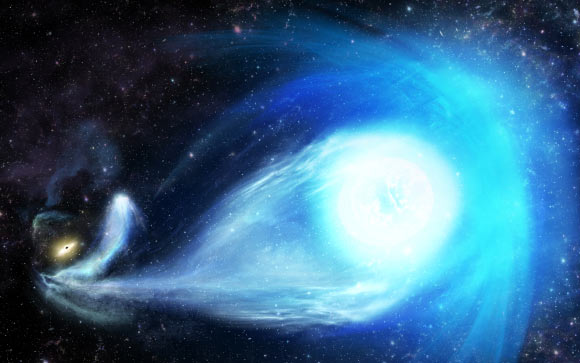A main-sequence hypervelocity star traveling at huge speeds after being ejected by Sagittarius A*, the supermassive black hole at the center of our Milky Way Galaxy, was spotted by an international team of astronomers.
Source: Sci News
Hypervelocity stars are fast-moving stars that move more than twice as fast as most other stars — more than 1 million mph (500 km/s).
Astronomers first discovered these stars in 2005. Nearly 30 HVSs have been discovered so far.
Hurtling at the blistering speed of 2.3 million mph (1,017 km/s), the newfound hypervelocity star is moving so fast that it will leave the Milky Way and head into intergalactic space.
Dubbed S5-HVS1, this star is currently located in the constellation of Grus at a distance of about 29,000 light-years.
“S5-HVS1’s velocity is so high that it will inevitably leave the Galaxy and never return,” said Dr. Douglas Boubert, an astronomer at the University of Oxford.
When integrated backwards in time, the orbit of the star points unambiguously to the Galactic center, implying that S5-HVS1 was kicked away from Sagittarius A* with a velocity of 4 million mph (1,800 km/s) and traveled for 4.8 million years to its current location.
“This is super exciting, as we have long suspected that black holes can eject stars with very high velocities,” said Dr. Sergey Koposov, a researcher at Carnegie Mellon University.
“However, we never had an unambiguous association of such a fast star with the Galactic center.”

Superfast stars can be ejected by black holes via the Hills mechanism, proposed by astronomer Jack Hills thirty years ago.
Originally, S5-HSV1 lived with a companion in a binary system, but they strayed too close to Sagittarius A*.
In the gravitational tussle, the companion star was captured by the supermassive black hole, while S5-HVS1 was thrown out at extremely high speed.
“This is the first clear demonstration of the Hills mechanism in action. Seeing this star is really amazing as we know it must have formed in the galactic center, a place very different to our local environment. It is a visitor from a strange land,” said Dr. Ting Li, from Carnegie Observatories and Princeton University.
The discovery was made as part of the Southern Stellar Stream Spectroscopic Survey (S5).
The astronomers used data from the 3.9-m Anglo-Australian Telescope and ESA’s Gaia satellite to reveal the full speed of the star and its journey from the Milky Way’s center.
“I am so excited this fast-moving star was discovered by S5,” said Dr. Kyler Kuehn, of Lowell Observatory.
“While the main science goal of S5 is to probe the stellar streams, we dedicated spare resources of the instrument to searching for interesting targets in the Milky Way, and voila, we found something amazing for ‘free.’ With our future observations, hopefully we will find even more.”
The team’s paper was published in the Monthly Notices of the Royal Astronomical Society.
Source: Sci News

































Leave a Comment
You must be logged in to post a comment.